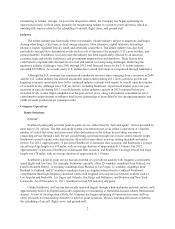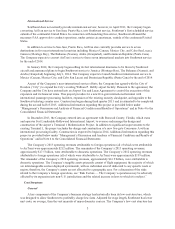Southwest Airlines 2013 Annual Report Download - page 18
Download and view the complete annual report
Please find page 18 of the 2013 Southwest Airlines annual report below. You can navigate through the pages in the report by either clicking on the pages listed below, or by using the keyword search tool below to find specific information within the annual report.flown. For the Company’s 2011 consolidated results, which include AirTran results from May 2, 2011, through
December 31, 2011, Customers of Southwest and AirTran redeemed approximately 3.7 million flight awards,
accounting for approximately 8.6 percent of revenue passenger miles flown. The Company’s accounting policies
with respect to its frequent flyer programs are discussed in more detail in Note 1 to the Consolidated Financial
Statements.
Other Initiatives
Network Optimization and Revenue Management
The Company uses profitability management tools to manage capacity and route expansion though
optimization of its flight schedule to, among other things, better match demand in certain markets. Using its
profitability management tools, the Company continually adjusts the Southwest and AirTran networks through
the addition of new markets and routes, the adjustment of frequencies in existing markets, and the exiting of
certain unsustainable markets and redeployment of aircraft to other markets. For example, prior to 2013, in
response to high fuel prices, the Company discontinued service in 15 AirTran destinations. As part of its network
optimization efforts, the Company ceased service to Bermuda during 2013. The Company improved its
operational network efficiency during 2013 by tightening its scheduled aircraft flying hours per day and turn
times to better utilize available aircraft time during the peak flying hours of each day. These efforts contributed
to higher yields, strong load factors, and improved revenues. As part of its continuing network optimization
efforts, the Company has announced its plans to cease Southwest operations in Branson, Missouri; Key West,
Florida; and Jackson, Mississippi beginning in June 2014. The Company believes the optimization and alignment
of the Southwest and AirTran schedules and networks can continue to yield significant synergies and other
benefits. Over the next several years, the Company also plans to develop new systems to support international
service and improve revenue management capabilities.
Cost Containment
Over the last several years, the Company has undertaken a number of cost-containment projects for the
purpose of preserving Southwest’s low-cost advantage and low-fare brand. These have included the fleet
modernization and network optimization strategies discussed above. Among other things, fleet modernization has
contributed to lower maintenance and repair expenses, and network optimization is enabling Employee
scheduling efficiencies.
In addition, these cost-containment projects have included various fuel conservation and carbon emission
reduction initiatives such as the following:
• installation of blended winglets, which reduce drag and increase fuel efficiency, on all Boeing
737-700 and 737-800 aircraft in Southwest’s fleet and on a majority of Southwest’s 737-300 aircraft;
• commitment to upgrade the Company’s 737-800 fleet during the 2014-2015 timeframe with newly
designed, split scimitar winglets;
• periodic engine washes;
• use of electric ground power for aircraft air and power at the gate and for ground support equipment
at select locations;
• deployment of auto-throttle and vertical navigation to maintain optimum cruising speeds;
• implementation of new engine start procedures to support the introduction of new single engine taxi
procedures;
• adjustment of the timing of auxiliary power unit starts on originating flights to reduce auxiliary
power unit usage;
10
























